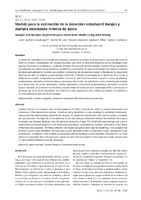Modelo para la estimación de la deserción estudiantil Awajún y Wampis empleando minería de datos
Awajún and Wampis student dropout estimation model using data mining
Date
2020-11-27Author
Quiñones Huatangari, Lenin
Jara, Diomer M.
Alvarado, Nicanor
Milla, Manuel E.
Gamarra, Oscar A.
Metadata
Show full item recordAbstract
La deserción estudiantil es un problema complejo y crucial en el campo de la educación, que está presente en todos los niveles y modalidades del sistema educativo, por tanto, la detección temprana es una estrategia clave para las instituciones académicas. La Minería de Datos Educacional permite modelar la deserción de estudiantes considerando sus datos socioeconómicos, académicos y personales. El objetivo del trabajo fue emplear la minería de datos para determinar modelos que estimen la deserción de estudiantes Awajún y Wampis de la Universidad Nacional de Jaén. Se empleó la metodología CRISP-DM: Entender el problema de la deserción del 45% de la población en estudio, comprender las variables, construir la matriz de datos de los cuarenta y nueve estudiantes, modelamiento utilizando el software Weka y evaluación del modelo. Se identificaron cinco variables que influyen en la deserción: Los cursos aprobados, créditos aprobados, comunidad de procedencia, promedio y ciclo de ingreso. Además, se proponen tres modelos con porcentaje de instancias bien clasificadas de 87.8, de los que se concluye que si los cursos aprobados, son inferiores a diez asignaturas o los créditos aprobados son menores a 27, el estudiante se retira de la Universidad. Student dropout is a complex and crucial problem in the field of education, which is present at all levels and modalities of the educational system. Therefore, early detection is a key strategy for academic institutions. Educational Data Mining allows modeling the dropout of registered students with their socioeconomic, academic and personal data. The objective of the work was to use data mining to determine models that estimate the dropout of Awajún and Wampis students from the National University of Jaén. The CRISP-DM methodology was used to understand the dropout problem of 45% of the study population, understand the variables and build the data matrix of the forty-nine students. The Weka software and model evaluation were used for modelling. Five variables that influence dropout were identified: the approved courses, approved credits, community of origin, average and cycle of admission. In addition, three models are proposed with percentages of well classified instances of 87.8, from which it is concluded that if the approved courses are less than ten subjects or the approved credits are less than 27, the student withdraws from the University.
URI
https://hdl.handle.net/20.500.12219/2839https://doi.org/10.36995/j.recyt.2020.34.006
https://www.fceqyn.unam.edu.ar/recyt/index.php/recyt/article/view/650
Collections
The following license files are associated with this item:




